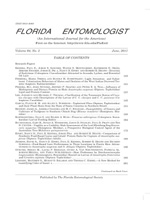The importance of soil organic matter for Tomaras subtropicus Blatchley larval development and survival, the amount of damage larvae could cause on turfgrasses, and potential larval host range were investigated in greenhouse experiments. First instars were reared individually in seedling trays containing sand or peat, with or without St. Augustinegrass. Survival, developmental stage, and final weight were recorded 1 month after introduction. First instars died in the pots with peat but no grass, so it appears that grass roots were critical for larval growth and development. Soil organic matter did not significantly affect grub weight gain and development, but more root loss occurred with grass grown in sand. In host range tests (2005 and 2006), first and third instars were reared on 6 species of warm season grasses and ryegrass. Grub weight gain, development, survival and grass root reduction were determined 2 months after introduction. Larval survival ranged from 62–93% if grubs were reared on warm season grasses to only 40% if reared on ryegrass. Grubs reared on warm season grasses gained weight and successfully developed into third instars, indicating that all of the tested warm season turfgrasses were suitable for larval T. subtropicus growth and development. Grub feeding caused significant root reduction of all grasses in our study, which ranged from 36 to 87% and differed among grass species. As result, quality ratings and clipping yields decreased for most of the turfgrasses after 5 weeks of infestation, but bahiagrass and seashore paspalum were less affected by T. subtropicus root feeding, compared to the other grass species.
How to translate text using browser tools
1 June 2011
Tomarus subtropicus (Coleoptera: Scarabaeidae) Larval Feeding Habits
Olga S. Kostromytska,
Eileen A. Buss

Florida Entomologist
Vol. 94 • No. 2
June 2011
Vol. 94 • No. 2
June 2011
Bermudagrass
grub weight gain and development
host range
root reduction
ryegrass
soil organic matter
St. Augustinegrass




